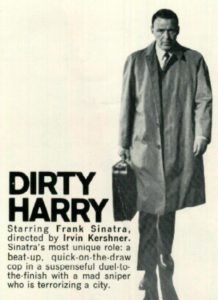Let’s be clear: “Magnum Force” (1973) is not only my favorite of the “Dirty Harry” film series, but also stands next to films like “The Seven-Ups” and “The French Connection” as my favorite of all police films ever to come out of Hollywood. But who knows? If things had gone the way originally intended, maybe cinema audiences would have never had legendary actor Clint Eastwood thrilling them as no-nonsense Harry Callahan in films like “Magnum Force,” “Sudden Impact,” “The Enforcer,” or “The Dead Pool.”
Few realize that before Eastwood and longtime collaborator Don Siegel entered the picture, the role of Harry Callahan was intended for a good actor who made his bones, so to speak as a singer of American popular music. That man was Frank Sinatra.
By the beginning of the 1970s, Frank Sinatra’s film career was waning. Although the late 1960s had seen him put in a good amount of mood-varying performances on the silver screen, including the gritty “The Detective” (1968) as well as the twin somewhat farcical private eye films “Tony Rome” (1967) and its sequel “Lady In Cement” (1968), the production of the forgettable western “Dirty Dingus Magee” in 1970 would basically serve as the virtual nadir of Sinatra’s film career until his return ten years later in “The First Deadly Sin” (1980). The poor performance of “Magee” was yet another mitigating factor that helped contribute to his first retirement from show business 1971-73) and “The First Deadly Sin” would bring an end to his film career, starring-wise.
Few realize, however, that before his 1971 retirement, negotiations had proceeded far enough along to even see the creation of a film promotional announcing Sinatra starring as “Dirty Harry” Callahan. Although the plot details are brief and sketchy (no doubt several changes were made once Eastwood and Siegel came aboard), the promo utilizes a photograph of a briefcase-carrying, trench coat-wearing Sinatra from his earlier 1967 film “The Naked Runner” to give audiences a vague idea as to what a Sinatra approach to the Callahan character might have been. The memory of Eastwood’s eventual performance is so ingrained in the mind of many a cinema lover nowadays that it’s kind of hard to imagine Ol’ Blue Eyes in such a role. This fan can only imagine he’d play the character along the same lines as his performance of Joe Leland in 1968’s “The Detective.” The performance as Leland was a good one, but when putting that up against Eastwood, the comparison of performances is, to quote a Sinatra song, like “night and day.”
For those who love Eastwood, what happened to Sinatra and his fate with “Dirty Harry” was perhaps good news. Years earlier in 1962, Sinatra had injured himself during the filming of a dramatic fight scene for the film “The Manchurian Candidate.” Acting out a battle with actor Henry Silva (in fact, the very first example of martial arts shown on the screen), his fellow actor moved away from a table off cue, and a pop originally intended to crack Silva at the back of his neck sent Sinatra’s arm swiping into the table hard enough to break the top, causing damage to his wrist and breaking his pinky finger. The injury would plague him for the rest of his life. Since “Dirty Harry” required Sinatra to carry and use a gun throughout the course of the picture and the old injury conflicted with his need to portray using a sidearm convincingly, the singer withdrew from the project. After several other actors were considered, Clint and Company entered the picture, and the rest, as they say, is history.
It is ironic that, besides Harry Callahan, two out of the next three projects that Sinatra would eventually turn down saw the actors who eventually took the roles creating landmark performances in films that are today considered stellar examples of great cinema. The first of these three involved a gentleman that Sinatra had worked with once on the MGM lot in 1955, an individual who the singer would eventually come to refer to as “Mumbles,” actor Marlon Brando. Sinatra’s irritation with Brando’s excessive obsession with re-takes of scenes, not to mention Brando beating out Sinatra for the role a few years earlier in the Hoboken-centered classic “On The Waterfront” led him to refer to the actor in conversation to both friends and audiences with annoyance for the rest of his life, often chastising Brando’s singing ability, of which he performed a great deal in “Guys and Dolls.”
By the dawn of the 1970s, Paramount Pictures had purchased the rights to a best-selling novel by Mario Puzo, a lengthy story telling the history of a New York crime family, the Corleone’s, known as “The Godfather.” Of course, it is known as perhaps the greatest of all crime films today, a veritable masterpiece, with two sequels to boot. However, in the early days of production, long before Francis Ford Coppola came along and studio officials were trying to figure out how to proceed with filming the book as a motion picture, the idea was tossed around to jettison the “period” theme of the novel (the 1940s and 1950s) and instead shoot the events of the novel as occurring in modern day (the 1970s), for the modest sum of a few million dollars.
With this angle in mind, revered movie maker Otto Preminger was summoned to direct. Having worked extensively with Preminger on “The Man With The Golden Arm” in 1955, Sinatra was considered for a brief time to play the character of the Mafia chieftain, Don Vito Corleone. As plans changed and the scope of “Godfather” as a picture mutated and grew, Preminger left the project, and along with him, Sinatra as a casting choice. Before long, Coppola came aboard, the period theme was reinstated to the film, and Paramount set about to create one of the great epics of our time. The studio displayed great reluctance, but as history would tell it, old Sinatra foe Marlon Brando would be cast in the role of the Don, perhaps the actor’s finest performance of all time. He would be awarded later, and would refuse, the Academy Award for Best Performance by a Lead Actor.
Sinatra was also in the running for a brief time to play the role of alcoholic lawyer Frank Galvin for the 20th Century Fox studio production of “The Verdict” in the early 1980s. Adapted for the screen from a novel by Barry Reed, it tells the story of beaten down drunk of a lawyer with a fading practice who mainly serves as an ambulance chaser for clients. A break comes in the form of a woman who was mistreated by doctors in a hospital affiliated with the Archdiocese of Boston, resulting in the patient entering a vegetative state. Facing a crisis of conscience in wanting to accept a modest settlement from the Church, the lawyer takes the case to trial, fighting for the helpless client and redeeming himself. Only two years after production of “The First Deadly Sin,” it seemed to be a role crafted for Sinatra. He would be in the running for the role against a battalion of other fine actors, including Cary Grant, Dustin Hoffman, and Robert Redford. Numerous script rewrites and conflicts resulted in all of these actors fading away from the production.
Actor Paul Newman, who co-starred with Sinatra in a television production of “Our Town” in 1955, would eventually take the reins as Galvin, and like Marlon Brando in “The Godfather” some ten years before, turned out a performance that is today considered one of the finest of his performance career. In addition, “The Verdict” itself is also considered one of the great “trial” films of all time today as well.
The final role that Sinatra would turn down took him back to land of the Mafia and Francis Ford Coppola, as the filmmaker was getting ready to shoot the third part of his Corleone family trilogy, “The Godfather, Part III,” in the very late 1980s. Sinatra would have played the role of Don Altobello, an aging fellow Mafia head and supposed friend of Don Michael Corleone and his family, all the time conspiring with dirty bankers, corrupt Vatican officials, and the Italian branch of the Mafia in an attempt to rob Corleone of his millions and remove him from the scene permanently.
Sinatra expressed a keen interest in the role, but turned it down due to his age. Approaching the age of seventy-five and facing the prospect of a world tour shortly to celebrate his diamond jubilee birthday (in a costly arrangement sponsored by Chivas Regal), as well as having to spend a period of months in Italy while the film was being shot, the singer closed the door on “The Godfather” saga once again. If you ask some people, they’ll tell you that Sinatra never got over the “Johnny Fontane” character being based on his early life in the novel and in the original 1972 film, and cite this as another reason for his refusal.
Instead, veteran actor Eli Wallach, who Sinatra himself beat out for the role of Private Maggio in his 1953 “comeback” film “From Here To Eternity” (interesting parallels when considering the Fontane angle for those who know the backstory), would take on the role of Altobello, and Wallach would serve as one of the more venerable villains in the “Godfather” story, putting in a memorable, two-faced performance.
As good as Wallach is, this is one of those roles I can see Sinatra in. I’m not sure how he would have proceeded to act out the character in terms of speaking and mannerisms, now that we know Wallach so well as Altobello, but at this point in his life and career, approaching the dawn of his eighties, and us knowing how with it Sinatra still was at this point in the late 1980s, I have a feeling he could have sunk his teeth well into the role if he had taken it. I can’t tell you how the performance would have come off, but I can definitely picture him well.
So, there you have it. Sinatra almost appearing in three classics, as well as what many refer to as the “disappointment” of “The Godfather, Part III.” It would have been interesting to see how these performances would have turned out if circumstances were different. For now, we’re left with the exemplary work of Clint Eastwood, Marlon Brando, Paul Newman, and Eli Wallach, and the presence of “alternate” trivia featuring our favorite balladeer in the American mainstream.
Until next time, Sinatra lovers!
Jerry Pearce is an amateur singer in the vein of Frank Sinatra, Perry Como, and Dick Haymes and has released two discs of standards music, Crossroads in 2010, and One Summer Night in 2016. Samples of his music can be heard on his YouTube Channel. To purchase his CDs use the form box below.
[si-contact-form form=’3′]

 June 14th, 2017
June 14th, 2017  CEO
CEO 
 Posted in
Posted in  Tags:
Tags: 



